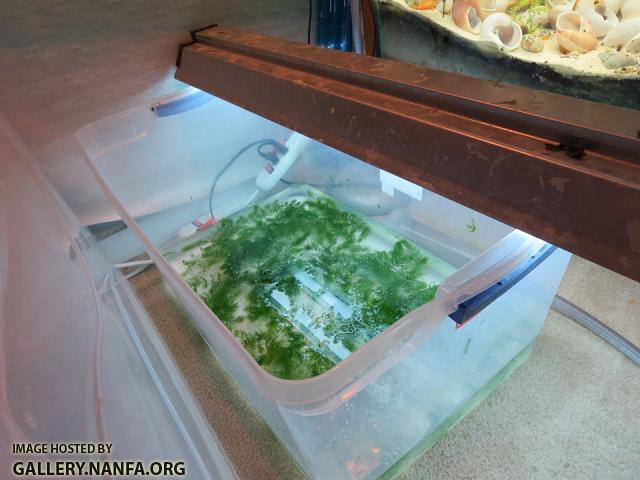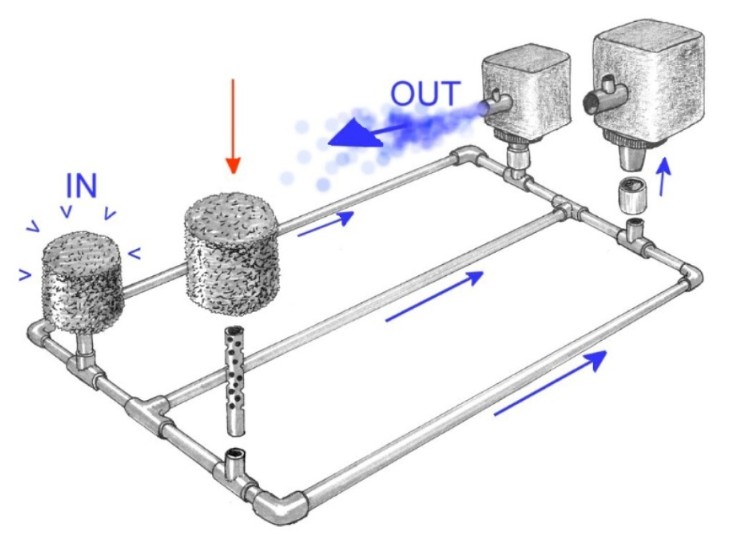Any natives for tanks without airation?
#1
 Guest_Joshaeus_*
Guest_Joshaeus_*
Posted 26 January 2014 - 05:19 PM
#2

Posted 26 January 2014 - 05:30 PM
#4
 Guest_Erica Lyons_*
Guest_Erica Lyons_*
Posted 26 January 2014 - 08:22 PM
I strongly agree. The only time you need mechanical aeration is if you've got lots of fish in a foot or more of water depth. There is a historical aquarium book that you can read here https://archive.org/...u31924001135189 called The freshwater aquarium and its inhabitants; a guide for the amateur aquarist published in 1908 by Otto Eggeling. Check it out. Right on pages 2 and 3 it's talking about aquarium shapes. This is way back from 1908, before electrically powered pumps were a thing and we could move water around the tank. It talks about surface area and gas exchange, and why tall tanks suck.Any fish can live without aeration.
Based on that reasoning in that book, I made this bucket tank:
http://www.youtube.com/watch?v=-uIvjlV6Z38
which is doing quite well. January 2014 update:
http://www.youtube.com/watch?v=GpcLMyjBWRM
I wish I remember when I set that tank up. It's been over a year but I can't remember if it's been one year or three.
I started keeping fish that I wanted to separate to sell in there, and that bucket started to generate more fry than the tanks of fish I'm actually trying to breed. lol
So I set one up for the elassoma okefenokee, and we'll see how they do.

http://gallery.nanfa...enokee.jpg.html
http://gallery.nanfa...eeding.jpg.html
http://gallery.nanfa... angle.jpg.html
It's been a few days. The disadvantage to a bucket tank is I can't see in it. I moved the plants aside and the males were colored black in spawning colors. I've yet to meet a fish that didn't like a bucket tank. Problem is it's tough to see in them. Display tanks are one reason to have mechanical water movement.
As to ammonia, there's ways to remove it other than the nitrite and nitrate generating bacteria that live on the high surface area materials in filters. They'll live on any surface area with water touching, including plant surfaces. And the plants themselves are quite functional.
http://www.theaquari...ical_Filtration
#5
 Guest_Subrosa_*
Guest_Subrosa_*
Posted 26 January 2014 - 09:07 PM
#7

Posted 26 January 2014 - 09:54 PM
#8
 Guest_Joshaeus_*
Guest_Joshaeus_*
Posted 27 January 2014 - 02:52 PM
I strongly agree. The only time you need mechanical aeration is if you've got lots of fish in a foot or more of water depth. There is a historical aquarium book that you can read here https://archive.org/...u31924001135189 called The freshwater aquarium and its inhabitants; a guide for the amateur aquarist published in 1908 by Otto Eggeling. Check it out. Right on pages 2 and 3 it's talking about aquarium shapes. This is way back from 1908, before electrically powered pumps were a thing and we could move water around the tank. It talks about surface area and gas exchange, and why tall tanks suck.
Interesting read, I say! Well, I guess a 48L inch by 12W by 8H inch tank would work wonders for elassoma...or would it? What do you guys think?
#11
 Guest_Erica Lyons_*
Guest_Erica Lyons_*
Posted 27 January 2014 - 04:00 PM
If your tank's 48 inches long, you could use one of the 48 inch 32 watt T8 fixtures, but that'd be something like 275 lumens per gallon (2750 lumens per Daylight Deluxe T8 bulb). Maybe if you suspended it a foot or so off the water, plants wouldn't get burned. (Can hairgrass get burned? It's a little light hog) But rest the light right on and it'd be great for a frag tank. You sure you don't want to grow corals? It'd work perfectly. That's the least expensive lighting setup for corals I've ever heard ($10 for the fixture from Walmart, $10 for two Daylight Deluxe bulbs from Home Depot). You might be one of the rare people who could do corals profitably.
Bucket tanks are nice, but I gotta say I also love the modern invention of powerheads. If you want to make this a sweet riffle tank, go for it. There are 1300 GPH powerheads on ebay for 2 for $25 including shipping. With a long tank like that you could do a pump setup like this:

http://www.loaches.c...-loach-aquarium
The high surface area to volume ratio will not go to waste; it'll improve the fish's quality of life with or without a powerhead. And if the power fails, the high surface area might protect the darters from death by suffocation. I have yet to lose a fish from a power outage, ever.
#12
 Guest_Joshaeus_*
Guest_Joshaeus_*
Posted 27 January 2014 - 04:18 PM
By the way, in a tank this size, do you think scarlet badis or some other dario could be kept with the elassoma?
Edited by Joshaeus, 27 January 2014 - 04:20 PM.
#13
 Guest_Erica Lyons_*
Guest_Erica Lyons_*
Posted 27 January 2014 - 04:36 PM
You could have a 10 gallon reserved for each species. Put two pairs in each 10 gallon and pull them out, generating fry regularly. Then keep the adults in a big display together. That'd work.
You can interchange 'bucket tank' for '10 gallon' at any point in my above paragraph. Wooo, bucket tanks. They are so awesome
#14
 Guest_Joshaeus_*
Guest_Joshaeus_*
Posted 27 January 2014 - 05:07 PM
Something else I've wondered about is whether leptolucania ommata would work with elassoma...obviously I'd need a lid in that circumstance (killies jump!), but they'd add a nice contrast to the elassoma without scaring them much (they're a 1", skinny, brassy yellow fish...can't see them getting confused for dominant male elassoma) and since the elassoma and leptolucania would be bred outside of the tank there would not be a huge issue with fry predation. Any thoughts?
#15
 Guest_Erica Lyons_*
Guest_Erica Lyons_*
Posted 27 January 2014 - 10:57 PM
That's the key. As long as you're producing fry elsewhere it doesn't matter if you've got a fryeater like leptolucania ommatta in with the adults. But I think a few elassoma fry will survive. Didn't Michael Wolfe say he had a mixed leptolucania and elassoma tank one time? Do you get fry, Michael?since the elassoma and leptolucania would be bred outside of the tank there would not be a huge issue with fry predation.
#16

Posted 28 January 2014 - 06:42 AM
Its too bad too, cause a ten gallon full of hornwort with round black fish and yellow dagger shaped fish moving around slowly is an amazing thing to see... but not really sustainable for more than a couple of years.
#17
 Guest_Joshaeus_*
Guest_Joshaeus_*
Posted 28 January 2014 - 07:28 AM
Anyhow, I am currently disputing between 2 setups for the tank, which in either case will be a florida biotope. Here are the two I am considering:
A - A tank with elassoma, maybe leptolucania (I would need a lid if I had leptolucania, which would be a problem with this tank...), ramshorn snails, and ghost shrimp.
B: A definitely lidded setup with L. ommata, Heterandria formosa, maybe ghost shrimp, and maybe Jordanella floridae (I'm worried they would either eat the aquascape, or attack their tank mates...hence the 'maybe'.)
What setup do you guys think I should go with? I am honestly considering different tank dimensions to try and solve the height/jumping/lights/etc issues...but are any of the above fish jumpers?
#18
 Guest_Dustin_*
Guest_Dustin_*
Posted 28 January 2014 - 08:18 AM
Leptolucania are almost certainly not going to jump out of an uncovered tank provided they have plenty cover. I think a tank with Heterandria, Leptolucania and Elassoma sounds wonderful. If I had the time and access to small live foods, I would do this exact tank. I have always had a fondness for the little guys.
#19
 Guest_Joshaeus_*
Guest_Joshaeus_*
Posted 28 January 2014 - 08:38 AM
So now, I likely have an option C: Elassoma, Leptolucania, and Heterandria - the only fish that will likely breed in this tank! - alongside ghost shrimp and ramshorns.
Edited by Joshaeus, 28 January 2014 - 08:38 AM.
#20
 Guest_Dustin_*
Guest_Dustin_*
Posted 28 January 2014 - 09:04 AM
I will say, ghost shrimp do jump out often so that may be one you will need to replace periodically.
Reply to this topic
1 user(s) are reading this topic
0 members, 1 guests, 0 anonymous users









